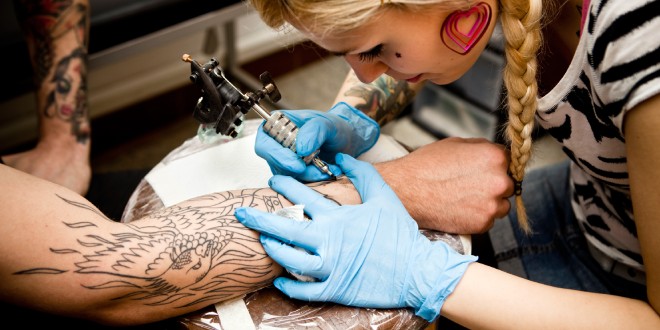Maybe your lover thinks tattoos are hot. Maybe you’re an activist with a message for everyone to see. Maybe it’s simply a Popeye fetish. Either way, getting a tattoo can be a big decision, and there are several things to consider before going under the needle.
Tattooing is a tradition of puncturing the skin and placing dye under its surface to create images or words. It started around 4000 B.C. in Ancient Egypt, and has since spread throughout the globe, taking on a myriad of meanings. The Burmese in 2000 B.C. incorporated tattooing into their magic. The Greeks used special tattoos for their spies. King Harold of Great Britain, in an everlasting romantic gesture, tattooed “Edith” above his heart. But before you rush out to emblazon your beloved’s name on your backside, keep in mind that this procedure is a permanent one. And even with today’s technology, removing it may not be as simple as you think.
Luckily, there is another option: the temporary tattoo. Applied to the top of your skin, instead of being injected underneath, the dye lasts anywhere from a few days to a couple of weeks.
Henna, a popular type of temporary tattoo, is a small shrub found in the Middle East. First used around 5000 B.C. for its natural healing properties, Henna has since become a popular body decoration in many cultures. The application is painless, and the paste dries soon thereafter, leaving a brownish-red hued tattoo that lasts up to 12 days before fading.
The other option for a temporary fix is a store-bought tattoo, which can be removed with a few good scrubbings.
What is it?
Tattooing is a tradition of puncturing the skin and placing dye underneath it to create images or words made of ink. It started around 4000 B.C. in Ancient Egypt, and has since spread throughout the globe, taking on a myriad of meanings. The Burmese in 2000 B.C. incorporated tattooing into their magic. The Greeks used special tattoos for their spies. King Harold of Great Britain, in an everlasting romantic gesture, tattooed “Edith” above his heart. But before you rush out to emblazon your beloved’s name on your backside, keep in mind that this procedure is a permanent one, and even with today’s technology, removing it may not be as simple as you think.
Luckily, there is another option: The temporary tattoo. Applied to the top of your skin, instead of being injected underneath, the dye lasts anywhere from a few days to a couple of weeks.
Henna, a popular type of temporary tattoo, is a small shrub found in the Middle East. First used around 5000 B.C. for its natural healing properties, Henna has since been a popular body decoration in many cultures. A tattoo artist creates a Henna paste, which he or she then paints onto your skin. Depending on the skill of the artist, designs can be extremely intricate and beautiful. The application is painless, and the paste dries soon thereafter, leaving a brownish-red hued tattoo that lasts for up to twelve days before fading.
The other option for a temporary fix is the store-bought tattoo. Choose a ready-made design, press it against your skin and rub a little water on top. Voila! All it takes to remove this type of tattoo is a few good scrubbings.
How is it done?
If you’re in the market for a permanent tattoo, head to your neighborhood tattoo parlor. The tattoo artist will point out many designs to choose from. And when you’re ready, he or she will use a needle to inject dye underneath your skin.
If your mind’s not made up, try a Henna or store-bought tattoo, both of which are temporary. Henna, a small shrub found in the Middle East, is made into a paste that is painted onto your skin. It dries into a brownish-red hue that lasts for about twelve days before fading. You can go to a Henna artist, or buy a kit and try your own designs! If Henna’s not your thing, take a look at the store-bought kind. They come with a ready-made designs that you place onto your skin and wet. This tattoo lasts for a few days, and a few good scrubbings will usually remove it.
How much does it cost?
How much it costs depends on what you want to get. If you’re looking for a cheap tattoo – and I mean cheap – scare up some change, hitch a ride to your local supermarket or mall and hit the vending machines. You’re likely to find a tamely designed press-on temporary tattoo.
If you’re hoping for Henna, be prepared to pay twenty dollars and up, depending on how large and detailed you’d like the design to be. If you’re feeling artsy, you can find kits on the web for around 10 to 20 dollars. They usually include templates, an applicator tube, pre-mixed Henna paste and gloves.
For the real deal, el permanente, prepare to lay out at least 50 bucks for starters. Larger, more detailed or more colorful designs can run you into the hundreds, even thousands of dollars and can require multiple visits.
Important considerations
Temporary tattoos don’t carry the health risks that permanent tattoos do, because the latter breaks through the skin, potentially exposing you to Hepatitis and HIV. And permanent tattoos hurt.
Luckily, there are guidelines that tattoo artists can follow to greatly reduce the chances of trouble. Ask them if they:
- wash their hands and wear latex gloves during the procedure
- use sterile, disposable needles that they open in front of their customers
- throw away ink caps, razors and stencils after every use
- use an autoclave (an intense heating process) to sterilize equipment, and have their autoclave inspected monthly
- sterilize the pigment bottles and the work area with bleach
- use an ultrasonic tank to rinse the tube and needle set from their tattoo machines
If you don’t get a satisfactory response to these questions, or if you notice something disturbing, like a dirty work space, remember: you can walk away and find a better tattoo parlor.
One last thought about permanent tattoos: don’t get one unless you want it forever. Yes, laser technology can help remove your tribute to “My Darling Peter” before it deflates your relationship with your new beau, Jay. But laser removal often requires multiple treatments, and the end result may only lighten your tattoo, or less often, leave you with an ugly scar.
Possible side effects
Pain and bleeding are common while you’re getting your permanent tattoo, and scabbing is common afterward. For the first few days, use an antibiotic cream on your tattoo, and if it doesn’t look infected, you can use cocoa butter for the remaining week or two until the scabbing subsides.
You may also experience an allergic reaction to the pigment dye. According to Jacob Baral, M.D., who practices tattoo removal in New York City, allergies include local swelling and itching. If you’re concerned, ask your tattoo artist to test a tiny portion of your skin to see if there’s a reaction before getting the tattoo. If you are allergic to a tattoo, the only way to stop the reaction is to have it removed!
Dangerous complications
The complications from an unsterile permanent tattoo procedure are almost unthinkable: you can contract HIV and Hepatitis B and C, among other bloodborne diseases. Transmission can occur if your tattoo artist injects you with a needle used on someone else. Hepatitis B can survive outside the body for days, increasing your chances of contracting it from a contaminated needle.
Luckily, transmission of disease through tattooing does not commonly occur.
How long is the healing process?
After you get a permanent tattoo, expect the healing process to take about two to three weeks. Bleeding is common during the procedure, and scabbing is common afterward. For the first few days, use an antibiotic cream on your tattoo, and if it doesn’t look infected, you can use cocoa butter for the remaining week or two until the scabbing subsides.
The healing process for tatoo removal varies, depending on the tattoo.
How do you reverse it?
Laser surgery for tattoo removal often requires multiple treatments, depending on the colors in your tattoo. Visits are spaced about 10 days apart, during which time your doctor may use antibiotics and a special dressing over the treated area to help it heal.
By Jon Garbo
Gay Health
 Lesbian, Gay, Bisexual, Transgender & Intersex News Lesbian News, Gay News, Bisexual News, Transgender News, Intersex News, LGBTI News
Lesbian, Gay, Bisexual, Transgender & Intersex News Lesbian News, Gay News, Bisexual News, Transgender News, Intersex News, LGBTI News




